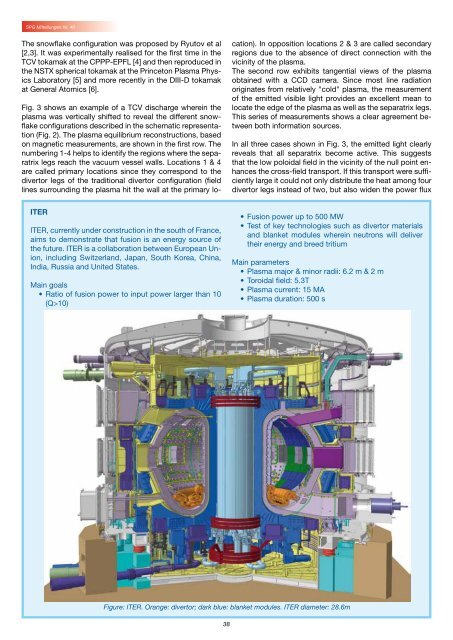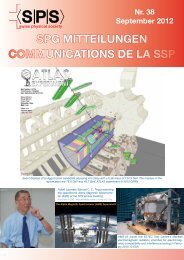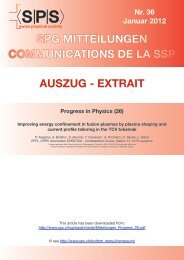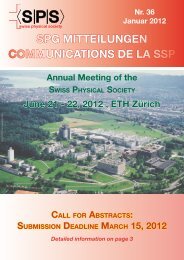spg mitteilungen communications de la ssp - Schweizerische ...
spg mitteilungen communications de la ssp - Schweizerische ...
spg mitteilungen communications de la ssp - Schweizerische ...
Create successful ePaper yourself
Turn your PDF publications into a flip-book with our unique Google optimized e-Paper software.
SPG Mitteilungen Nr. 40<br />
The snowf<strong>la</strong>ke configuration was proposed by Ryutov et al<br />
[2,3]. It was experimentally realised for the first time in the<br />
TCV tokamak at the CPPP-EPFL [4] and then reproduced in<br />
the NSTX spherical tokamak at the Princeton P<strong>la</strong>sma Physics<br />
Laboratory [5] and more recently in the DIII-D tokamak<br />
at General Atomics [6].<br />
Fig. 3 shows an example of a TCV discharge wherein the<br />
p<strong>la</strong>sma was vertically shifted to reveal the different snowf<strong>la</strong>ke<br />
configurations <strong>de</strong>scribed in the schematic representation<br />
(Fig. 2). The p<strong>la</strong>sma equilibrium reconstructions, based<br />
on magnetic measurements, are shown in the first row. The<br />
numbering 1-4 helps to i<strong>de</strong>ntify the regions where the separatrix<br />
legs reach the vacuum vessel walls. Locations 1 & 4<br />
are called primary locations since they correspond to the<br />
divertor legs of the traditional divertor configuration (field<br />
lines surrounding the p<strong>la</strong>sma hit the wall at the primary location).<br />
In opposition locations 2 & 3 are called secondary<br />
regions due to the absence of direct connection with the<br />
vicinity of the p<strong>la</strong>sma.<br />
The second row exhibits tangential views of the p<strong>la</strong>sma<br />
obtained with a CCD camera. Since most line radiation<br />
originates from re<strong>la</strong>tively "cold" p<strong>la</strong>sma, the measurement<br />
of the emitted visible light provi<strong>de</strong>s an excellent mean to<br />
locate the edge of the p<strong>la</strong>sma as well as the separatrix legs.<br />
This series of measurements shows a clear agreement between<br />
both information sources.<br />
In all three cases shown in Fig. 3, the emitted light clearly<br />
reveals that all separatrix become active. This suggests<br />
that the low poloidal field in the vicinity of the null point enhances<br />
the cross-field transport. If this transport were sufficiently<br />
<strong>la</strong>rge it could not only distribute the heat among four<br />
divertor legs instead of two, but also wi<strong>de</strong>n the power flux<br />
ITER<br />
ITER, currently un<strong>de</strong>r construction in the south of France,<br />
aims to <strong>de</strong>monstrate that fusion is an energy source of<br />
the future. ITER is a col<strong>la</strong>boration between European Union,<br />
including Switzer<strong>la</strong>nd, Japan, South Korea, China,<br />
India, Russia and United States.<br />
Main goals<br />
• Ratio of fusion power to input power <strong>la</strong>rger than 10<br />
(Q>10)<br />
• Fusion power up to 500 MW<br />
• Test of key technologies such as divertor materials<br />
and b<strong>la</strong>nket modules wherein neutrons will <strong>de</strong>liver<br />
their energy and breed tritium<br />
Main parameters<br />
• P<strong>la</strong>sma major & minor radii: 6.2 m & 2 m<br />
• Toroidal field: 5.3T<br />
• P<strong>la</strong>sma current: 15 MA<br />
• P<strong>la</strong>sma duration: 500 s<br />
Figure: ITER. Orange: divertor; dark blue: b<strong>la</strong>nket modules. ITER diameter: 28.6m<br />
38










